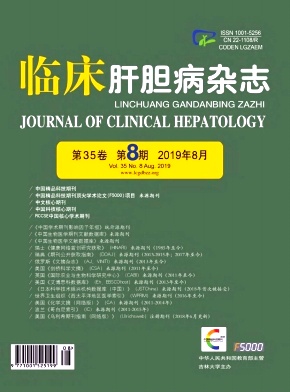|
[1] BRAY F, FERLAY J, SOERJOMATARAM I, et al. Global cancer statistics 2018:GLOBOCAN estimates of incidence and mortality worldwide for 36 cancers in 185 countries[J]. CA Cancer J Clin, 2018, 68 (6) :394-424.
|
|
[2] LLOVET JM, ZUCMAN-ROSSI J, PIKARSKY E. Hepatocellular carcinoma[J]. Nat Rev Dis Primers, 2016, 2:16018.
|
|
[3] LLOVET JM, MONTAL R, SIA D, et al. Molecular therapies and precision medicine for hepatocellular carcinoma[J]. Nat Rev Clin Oncol, 2018, 15 (10) :599-616.
|
|
[4] MAHDESSIAN H, TAXIARCHIS A, POPOV S, et al. TM6SF2 is a regulator of liver fat metabolism influencing triglyceride secretion and hepatic lipid droplet content[J]. Proc Natl Acad Sci U S A, 2014, 111 (24) :8913-8918.
|
|
[5] KOZLITINA J, SMAGRIS E, STENDER S, et al. Exome-wide association study identifies a TM6SF2 variant that confers susceptibility to nonalcoholic fatty liver disease[J]. Nat Genet, 2014, 46 (4) :352-356.
|
|
[6] CHALASANI N, WILSON L, KLEINER DE, et al. Relationship of steatosis grade and zonal location to histological features of steatohepatitis in adult patients with non-alcoholic fatty liver disease[J]. J Hepatol, 2008, 48 (5) :829-834.
|
|
[7] KE RS, ZHANG K, LV LZ, Et al. Prognostic value and oncogene function of heterogeneous nuclear ribonucleoprotein A1overexpression in HBV-related hepatocellular carcinoma[J].Oncol Lett, 2018, 16 (3) :3746-3756.
|
|
[8] ANAYA J. OncoLnc:Linking TCGA survival data to mRNAs, miRNAs, and lncRNAs[J]. Peer J Computer Science, 2016, 2:e67.
|
|
[9] GAO J, AKSOY BA, DOGRUSOZ U, et al. Integrative analysis of complex cancer genomics and clinical profiles using the cBioPortal[J]. Sci Signal, 2013, 6 (269) :pl1.
|
|
[10] VASAIKAR SV, STRAUB P, WANG J, et al. LinkedOmics:Analyzing multi-omics data within and across 32 cancer types[J]. Nucleic Acids Res, 2017, 46 (D1) :d956-d963.
|
|
[11] HUANG DW, SHERMAN BT, LEMPICKI RA. Systematic and integrative analysis of large gene lists using DAVID bioinformatics resources[J]. Nat Protoc, 2009, 4 (1) :44-57.
|
|
[12] SZKLARCZYK D, FRANCESCHINI A, WYDER S, et al. STRING v10:Protein-protein interaction networks, integrated over the tree of life[J]. Nucleic Acids Res, 2014, 43 (D1) :d447-d452.
|
|
[13] ZHANG YP, WANG F, CHEN PF, et al. Expression and significance of the ABAT gene in hepatocellular carcinoma:An analysis based on data mining[J]. J Clin Hepatol, 2019, 35 (3) :553-558. (in Chinese) 张玉鹏, 王帆, 陈鹏飞, 等.基于数据挖掘分析ABAT基因在肝细胞癌中的表达及意义[J].临床肝胆病杂志, 2019, 35 (3) :553-558.
|
|
[14] ESLAM M, GEORGE J. Genetic and epigenetic mechanisms of NASH[J]. Hepatol Int, 2016, 10 (3) :394-406.
|
|
[15] ESLAM M, VALENTI L, ROMEO S. Genetics and epigenetics of NAFLD and NASH:Clinical impact[J]. J Hepatol, 2018, 68 (2) :268-279.
|
|
[16] ROMEO S, KOZLITINA J, XING C, et al. Genetic variation in PNPLA3 confers susceptibility to nonalcoholic fatty liver disease[J]. Nat Genet, 2008, 40 (12) :1461-1465.
|
|
[17] DONGIOVANNI P, ROMEO S, VALENTI L. Genetic factors in the pathogenesis of nonalcoholic fatty liver and steatohepatitis[J]. Biomed Res Int, 2015, 2015:460190.
|
|
[18] ANSTEE QM, SETH D, DAY CP. Genetic factors that affect risk of alcoholic and nonalcoholic fatty liver disease[J]. Gastroenterology, 2016, 150 (8) :1728-1744. e7.
|
|
[19] FALLETI E, CUSSIGH A, CMET S, et al. PNPLA3 rs738409and TM6SF2 rs58542926 variants increase the risk of hepatocellular carcinoma in alcoholic cirrhosis[J]. Dig Liver Dis, 2016, 48 (1) :69-75.
|
|
[20] RAKSAYOT M, CHUAYPEN N, KHLAIPHUENGSIN A, et al. Independent and additive effects of PNPLA3 and TM6SF2 polymorphisms on the development of non-B, non-C hepatocellular carcinoma[J]. J Gastroenterol, 2019, 54 (5) :427-436.
|
|
[21] YANG J, TREPO E, NAHON P, et al. PNPLA3 and TM6SF2variants as risk factors of hepatocellular carcinoma across various etiologies and severity of underlying liver diseases[J]. Int J Cancer, 2019, 144 (3) :533-544.
|
|
[22] MELLO T, MATEROZZI M, GALLI A. PPARs and mitochondrial metabolism:From NAFLD to HCC[J]. PPAR Res, 2016, 2016:7403230.
|
|
[23] KIMURA O, KONDO Y, SHIMOSEGAWA T. PPAR could contribute to the pathogenesis of hepatocellular carcinoma[J].PPAR Res, 2012, 2012:574180.
|
|
[24] DAI HH, MEI LQ. Advances in nonalcoholic fatty liver disease and hepatocellular carcinoma research[J]. J Clin Hepatol, 2012, 28 (10) :797-800. (in Chinese) 代鸿华, 梅礼强.非酒精性脂肪性肝病与肝细胞癌关系的研究进展[J].临床肝胆病杂志, 2012, 28 (10) :797-800.
|
|
[25] DIEHL AM, DAY C. Cause, pathogenesis, and treatment of nonalcoholic steatohepatitis[J]. N Engl J Med, 2017, 377 (21) :2063-2072.
|







 DownLoad:
DownLoad: